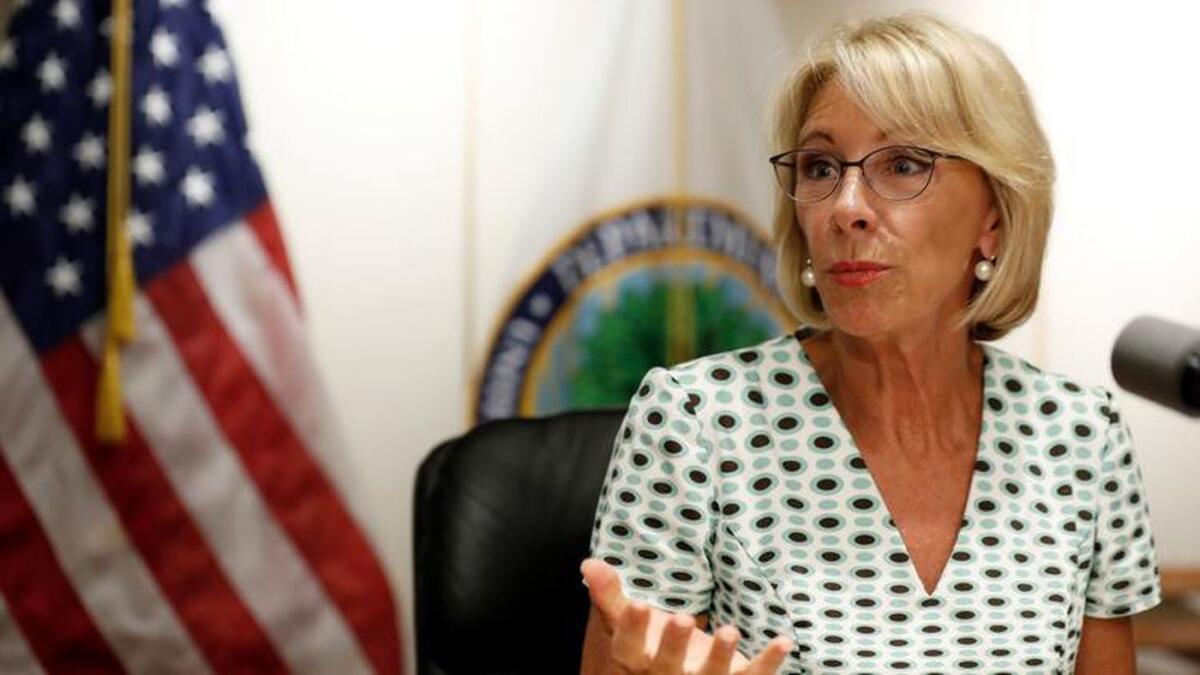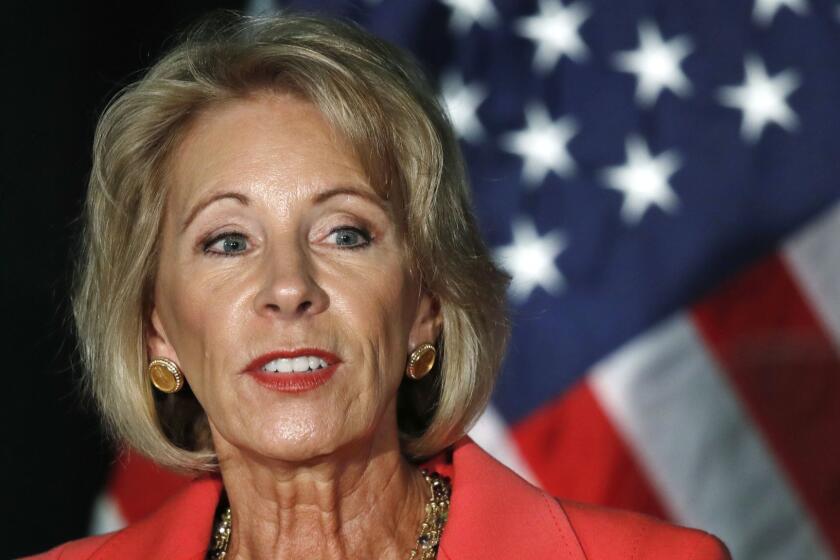Column: Canceling student debt should be a slam dunk. Here’s why

The question of whether the government should cancel the $1.6 trillion in student debt held by 43 million American adults drifted out of the political debate after the strongest advocates for the idea, Sens. Elizabeth Warren and Bernie Sanders, left the race for the presidential nomination.
It’s back. That’s because President-elect Joe Biden has endorsed canceling at least $10,000 in federally held loans per borrower as a COVID-19 relief measure (Democrats in Congress want to raise the figure to $50,000).
Biden also proposes easing payment terms for most borrowers and taking other steps to cut the financial burden for low-income college students.
The relative burden of education debt has long been higher for families with lower net worth, and...this disparity has grown much wider in the past couple decades.
— Janet Yellen, then-chair of the Federal Reserve, in 2014
Biden’s proposal has also revived the arguments against canceling student debt, which tend to revolve around issues of fairness. Accordingly, it’s proper to take a look at the pros and cons. Spoiler alert: Canceling student debt will yield huge benefits for individual borrowers and for the economy at large, and the more the better.
In reality, most student debt is destined to be canceled eventually, observes University of Utah economist Marshal Steinbaum, a senior fellow at the Jain Family Institute, a social science research organization.
That’s the harvest of the increased popularity of income-driven repayment programs, which cap annual repayments at a percentage of a borrower’s income and forgives any balance remaining after a set period — 20 years for undergraduate loans and 25 for graduate or professional study.
“Cancelation is the thing that everyone’s waiting for,” Steinbaum told me. “So why are we making them wait? Why don’t we just recognize that these are bad loans and eat them now?”
Let’s dispense with the two most common objections to student-debt forgiveness. The first is that canceling existing debt would be unfair to the millions of borrowers who met their obligations and now would have to sit by and watch deadbeats receive a windfall.
The student debt crisis reentered the news cycle Monday (has it ever really gone away?) when Sen.
As I’ve observed in the past, it’s hard to imagine a weaker objection or a more crass formula for governmental paralysis. By its logic, we wouldn’t have Social Security or Medicare today. The argument would be: “My great-grandparents starved in old age and died in the street because they couldn’t get healthcare, so why should yours get a break?”
In truth, the sacrifices some families made to shoulder their debt burden underscores the folly of forcing families to impoverish themselves to attain higher education. Why should we want to ignore the lesson?
The second often-heard objection is that debt cancellation would be a gift to relatively affluent households and to graduates of law, business and medical schools, who complete their education with large debt balances but are entering high-paying fields.
That’s true, but not especially relevant to the problem. Graduates of professional schools account for nearly 12% of the total debt outstanding but only about 4% of borrowers. What’s important is the debt burden on the majority of borrowers, who are working-class and lower-income.
According to an analysis by the Washington Center for Equitable Growth, a progressive think tank, the debt-to-income ratio among households in the lower 50% of the income ladder that hold any student debt is about 1-to-1 — that is, their loan balances are about the same as their annual income.
What’s especially worrisome is that the ratio has more than doubled only since 2001. The ratios for higher-income households also have increased, but remain below 0.25. (in other words, their balances are less than 25% of annual income.)
Black borrowers come off as especially disadvantaged in this calculation — about 30% of them have debt-to-income ratios of more than 0.5. Fewer than 20% of white borrowers have the same burden.
Presidential candidate Elizabeth Warren unveiled her plan to address the student debt mess Monday and promptly took brickbats because it would help higher-income families more than the poor.
That argues against a cap on debt forgiveness, Steinbaum says. Minority borrowers tend to end up with heavier debt burdens because their families are less able to support them in college, and because they generally need to get more advanced degrees to keep pace in the job market with white graduates.
“A policy that has a debt cap can always be made more racially egalitarian by increasing that cap,” Steinbaum says.
The economic establishment seems to believe that student debt forgiveness is a macroeconomic loser.
Among the more than 40 U.S. academic economists polled on the topic recently by the University of Chicago’s Booth School of Business — as solid a picture of academic thinking along the entire ideological spectrum that one could hope for — 60% agreed with the statement that “having the government issue additional debt to pay off all current outstanding student loans would be net regressive.” (That is, they thought it would benefit wealthier households the most.)
None disagreed with the statement, though 15 of the respondents, or 35%, were uncertain.
Many of the responses from the economists sounded as if their views are colored by their own environment (economics departments at elite institutions, some at business school) and their station in life (affluent).
David Autor of MIT, for example, bought into the “I paid, why shouldn’t everyone else?” camp: “Alongside my kids’ student loans, I’d like the government to pay off my mortgage. If the latter idea shocks you, the first one should too,” he stated in a comment appended to his vote.
Autor’s MIT colleague Daron Acemoglu remarked that the “risk of handout to yuppies is there” since there’s “lots of student debt among those earning more than 100K a year.”
In the broader policy-making world, however, there’s more agreement that the tide of student debt is a drag on the economy, which suggests that relief would be progressive, not regressive, and that it’s contributing to a racial divide in economic opportunity.
The student debt crisis is sufficiently horrific to have generated a plethora of ideas for relief, from refinancing government loans to make them more affordable (Sen.
“College costs have risen much faster than income for the large majority of households since 2001 and have become especially burdensome for households in the bottom half of the earnings distribution,” Janet Yellen, President-elect Biden’s choice for Treasury secretary, said in 2014 when she was chair of the Federal Reserve Board.
“The relative burden of education debt has long been higher for families with lower net worth, and ... this disparity has grown much wider in the past couple decades,” Yellen said.
Households with high student debt are less likely to buy a home, start a business or sustain themselves through economic downturns, reported Steinbaum, economist Stephanie Kelton, and colleagues in 2018. They have less disposable income, another drag on general economic growth.
The authors of that report argued that opposition to student debt forgiveness based on the ability of most borrowers to repay their debt over time was misguided. That’s because although “the median debt burden has not changed very much ... the median borrower has changed a great deal.”
In the past, borrowers “were likely to come from the ranks of ‘traditional students’ — that is, those attending either graduate school or private four-year institutions right after high school, often with a family history of higher education and with the family wealth to accompany it,” they observed.
More recently, however, borrowers are “much more likely to be nontraditional students, often beginning later in life and without a family background of college attendance.”
A federal magistrate has blocked the U.S.
Indeed, these were students targeted by for-profit higher education institutions. Those schools have tended to have high tuition costs, especially relative to the employment opportunities of their graduates.
The Obama administration cracked down on the for-profit sector and offered defrauded students loan forgiveness, but both policies were reversed by President Trump’s education secretary, the majestically useless Betsy DeVos.
Unsurprisingly, DeVos has emerged as a leading critic of student debt forgiveness. “We’ve heard shrill calls to cancel, to forgive, to make it all free,” DeVos said at a Department of Education function this week. “Any innocuous label out there can’t obfuscate what it really is: wrong.”
DeVos, who is related by marriage to the Amway multilevel marketing empire and sister of Erik Prince, founder of the mercenary military firm Blackwater, also condemned Biden’s proposal for tuition-free college as “a socialist takeover of higher education.”
Of course that overlooks the tradition of free public university education that was once exemplified by the University of California, which was once guaranteed tuition-free by the state constitution.
That tradition is relevant to the student debt debate, because one factor in the debt explosion is the withdrawal of government support for public higher education.
“States withdrew funding for public higher ed, tuition went up, and the whole premise of higher education went from being a public good to a private good,” Steinbaum told me. “The federal student loan system is supposed to be the way that private individuals finance their education, and the reason they would do that is that it leads to higher salaries that enable them to pay back their debts.”
But that assumption has proved to be flawed. Tuition increases are out of control, and the realities of the modern job market undercut the old truism that income rises with the accumulation of degrees.
Income-driven repayment schemes just paper over the flaw, creating “an extremely lengthy passing of the buck” to bail out borrowers, Steinbaum argues.
He’s right. Biting the bullet now means recognizing that the privatization of higher education is a failed process. The evidence of the failure is manifest in the tide of debt itself.
America is a land that never ceases to pay lip service to the value of education and almost never manages to back up its honeyed words with the resources necessary to make them true.
“Higher education has been and remains a potent source of economic opportunity in America,” Yellen said in that 2014 speech, “but I fear the large and growing burden of paying for it may makes it harder for many young people to take advantage of the opportunity higher education offers.”
Assuming that she’s confirmed as Treasury secretary, she and her fellow members of the Biden administration will be in a position to do something about it. Canceling student debt shouldn’t even be a matter for debate.









